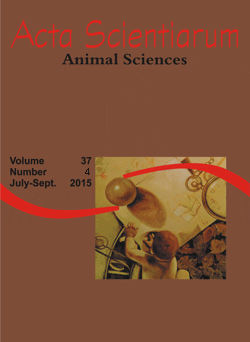<b>Aging time of five muscles from carcass of Nellore young bulls
Abstract
This trial aimed to assess the qualitative traits of five muscles of 14 Nellore bulls with 450 kg ± 30.7 kg BW, feedlot fed for 60 days. After slaughter and carcass chilling, samples of the Biceps femoris (BF), Longissimus (LD), Gluteus medius (GM), Semitendinosus (ST) and Trapezius thoracis (TT) muscles were collected, vacuum-packed and aged at 0 to 2 ºC for 1, 7 and 14 days and subsequently stored at –20ºC for chemical and quality analysis. The pH, shear force, water holding capacity, cooking losses, meat color and ether extract were evaluated in all aging times. Data were analyzed in a split-plot design using the PROC MIXED procedure of SAS. Aging affected quality traits and chemical properties of the meat, improving aspects, such as tenderness (p < 0.01) and lightness (p < 0.01). The Trapezius thoracis muscle has a higher color stability compared with the Longissimus muscle. Aging is not recommended for the ST muscle because the tenderness is not improved. The GM and BF muscles are tender on the first day, and the aging process is indicated for these cuts for adding value to the beef.
Downloads
DECLARATION OF ORIGINALITY AND COPYRIGHTS
- I Declare that current article is original and has not been submitted for publication, in part or in whole, to any other national or international journal.
The copyrights belong exclusively to the authors. Published content is licensed under Creative Commons Attribution 4.0 (CC BY 4.0) guidelines, which allows sharing (copy and distribution of the material in any medium or format) and adaptation (remix, transform, and build upon the material) for any purpose, even commercially, under the terms of attribution.
Read this link for further information on how to use CC BY 4.0 properly.








































